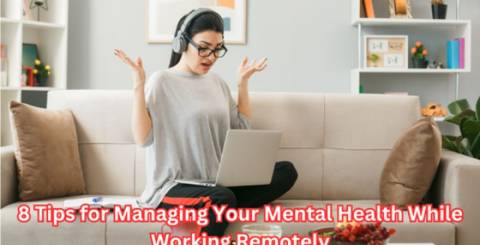8 Tips for Managing Your Mental Health While Working Remotely

Have you considered how remote work affects your mental health? While it offers flexibility, it also brings challenges like isolation, blurred work-life boundaries, and the pressure of managing a flexible schedule, which can impact your emotional well-being.
However, several strategies can help you manage your mental health while working remotely. In this blog, we will explore 8 practical tips to help you maintain emotional balance and stay productive in a remote work environment.
1. Set Up a Dedicated Workspace
Importance of Workspace Separation
Setting up a specific workspace is crucial to your mental and physical well-being while working remotely. Creating clear boundaries between your workspace and your personal space can significantly reduce distractions and help you maintain focus.
Understanding the difference between behavioral health vs mental health is also important, as it helps in identifying the emotional and psychological factors that affect your work-life balance. A dedicated workspace helps you mentally prepare for productive work and signals your brain that this is the time and space for professional tasks.
Ergonomics and Comfort
Your workspace needs to be ergonomic, both physically and mentally. Ergonomic furniture, such as a supportive chair and desk, can collectively prevent actual physical strain. A comfortable configuration will improve posture and reduce discomfort, which helps elevate your mood and boost productivity throughout the day.
2. Establish a Routine and Stick to Working Hours
Clear Start and End Times
Maintaining consistent work hours can help reduce stress and prevent burnout. A start and end will help regulate the flow of your day to keep work separate from personal life. Setting boundaries makes it easier to separate work from personal time, promoting a better work-life balance.
Regular Breaks for Mental and Physical Well-being
Take breaks frequently to keep your mind fresh. Take some time off from the workstation, stretch a little, or take a short walk to refresh your mind. These breaks reduce fatigue, helping you focus better on your work throughout the day. This helps keep your mind clear and healthy.
How Breaks Help You Stay Productive
Taking a walk or stretch during breaks can enhance your mood and energy. These little activities, contrary to what you may think them to be, help you avoid burnout, keep you on track, and keep you more energetic throughout the day.
3. Stay Connected with Colleagues
Remote work can sometimes lead to feelings of isolation and a sense of disconnection from colleagues. However, regular virtual meetings can foster consistent communication and keep interactions lively. Incorporating virtual team-building activities also helps strengthen relationships and create a sense of camaraderie.
Casual virtual meetups, like virtual coffee breaks or happy hours, provide an informal setting to connect and can significantly reduce feelings of loneliness. Staying engaged with colleagues through these activities can boost morale, enhance team cohesion, and support overall mental well-being.
4. Practice Mental Health Awareness
Recognizing the Signs of Stress
Being aware of your mental health is important, and having an early warning system for recognizing stress can be an essential step to managing it. As soon as you start feeling overwhelmed or anxious, it is crucial to check in with yourself.
However, acknowledging these feelings allows you to take the necessary steps to control them before they worsen.
Leverage Mental Health Resources
Many employers offer mental health resources, including counseling services and wellness programs. If you're overwhelmed, don't wait. Seeking support early makes it less likely for overwhelming feelings to become a chronic issue.
5. Prioritize Physical Activity
Benefits of Regular Exercise
Besides fitness, physical activity is an essential factor contributing to the improvement of mental well-being. It removes stress, anxiety, and tiredness, thus being the best way to stay mentally fit and alert at work.
Take a few minutes to work out - any form of workout that you can handle, whether it is a short session, yoga, or a brisk walk. Improved mood and productivity can help you regain control over your mental health.
Combatting Sedentary Behavior
Prolonged sitting times can harm the body as well as the mind. An increase in idle time could lead to worsening conditions for anxiety and depression. Simple workplace exercises or activities such as taking walks or stretches, and huge benefits from such actions follow in improved blood flow and cognitive performance with productivity and efficiency.
6. Set Clear Boundaries Between Work and Personal Life
Remote work offers flexibility, but without clear boundaries, it can quickly seep into your personal life. You have to respect your personal time and avoid giving in to overwork in order to be healthy both mentally and physically.
Setting clear distinctions between work and personal life ensures that you stop living with the pressure of having to be "on" all the time.
Develop habits, like eating lunch outside your workplace or having some areas in your home marked as "no work" zones, to help you disconnect. Such habits maintain a healthy balance between professional and personal life, preventing burnout.
7. Maintain Flexibility
Flexibility is typically required in working from home; sometimes, a person has to respond to their work responsibilities as well as other family or personal obligations on the same day. If you have to alter your schedule or need to have a mental health day, you need to communicate this with your employer.
Most companies will provide flexibility in order for the workplace welfare of an employee to be balanced through work-life integration. Flexibility in daily routines allows you to reduce the risk factors contributing to stress and makes you feel like you are in control of your workday.
It allows you to be able to take care of yourself and responsibilities without being overburdened. Flexibility ensures that both professional tasks and personal needs are addressed, promoting a healthier work-life balance.
8. Seek Support and Speak Up
Reaching Out for Help
● If you're feeling overwhelmed, reach out for support from your supervisor, HR department, or a mental health professional.
● Seeking help is a proactive way to manage stress and avoid burnout.
● Many companies have support systems in place, such as mental health programs, to assist their employees.
● Fostering a culture of open communication ensures employees feel comfortable sharing struggles without fear of judgment.
Conclusion
Managing mental health while working remotely means some structure involved. A dedicated workspace, sticking to a routine, staying active, and being in contact with your colleagues can be used to improve overall well-being. Being aware of when a buildup of stress occurs maximizes the possibility of having time to take time out and prevents burnout.
However, maintaining mental health is a lifelong commitment. Continued practice of these approaches year in and year out will promote balance between work and life and create better mental health, efficiency at work, and harmony between work and life.
Only long-term success on the personal as well as professional fronts can result from mentoring a well-founded remote work environment with mental well-being at the heart of it.
Frequently Asked Questions
1. Why is it important to talk about mental health at work?
Talking about mental health at work is crucial because it reduces stigma, promotes a supportive environment, and enhances employee well-being and productivity.
2. How does poor mental health affect the workplace?
Poor mental health in the workplace can lead to decreased productivity, higher absenteeism, increased turnover, and negatively affect employee engagement and morale.
3. How does mental health affect your ability to work?
Poor mental health can impair concentration, decision-making, and problem-solving, leading to decreased productivity, higher stress, and an increased risk of burnout.
Similar Articles
For cancer patients experiencing hair loss, a comfortable and stylish head covering can make a world of difference in boosting confidence and providing warmth. Creating headwear tailored to their needs requires thoughtful material choices, gentle designs, and a touch of creativity.
Going through a phase of addiction recovery is never easy, no matter how early you start treatment intervention.
In recent years, medical tourism has emerged as a thriving global phenomenon, with millions of patients crossing borders to seek high-quality healthcare services abroad
Struggling to hear? Learn the signs of hearing loss, the risks of ignoring it, and how modern hearing aids can improve your life. Take action today!
Explore various addiction recovery programs, from inpatient to outpatient and therapy options. Find the right path to sobriety and lasting recovery in this comprehensive guide.
Learn how to combine FSS and Medicaid Waiver Services for maximum benefit. FSS offers immediate family support, while Medicaid Waiver focuses on long-term individual care.
Our bodies hold a fantastic transport web under the skin. These hidden roads are our veins, which help move blood around so we can stay active and alert. They are small streams that lead back to the heart, carrying essential nutrients and oxygen.
Do you ever ask yourself why athletes and fitness enthusiasts rely on ice baths to help their sore muscles relax more?
Learn why dust extractor equipment is vital for hospitals, ensuring cleaner, healthier environments by eliminating harmful dust, allergens, and germs.









